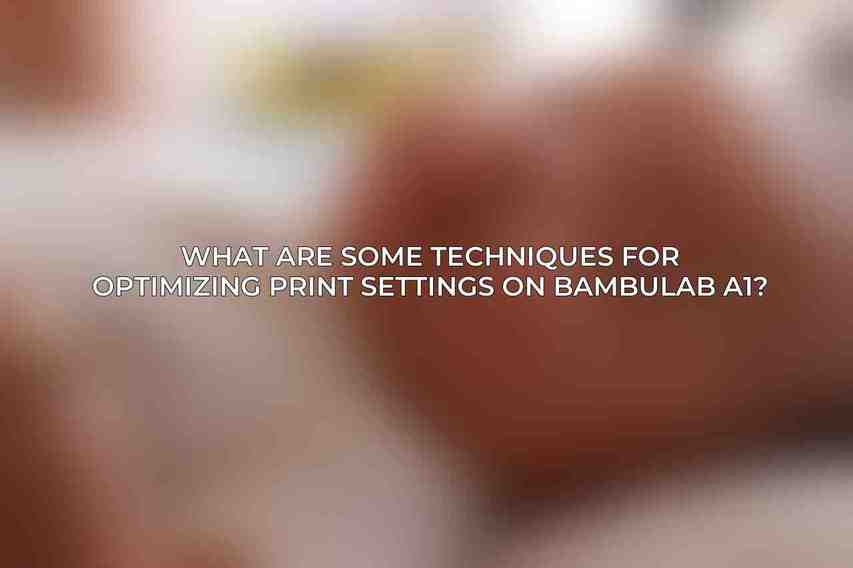3D printing has revolutionized the way we create various objects, allowing for intricate designs and personalized items. The ability to customize 3D prints opens up a world of possibilities for users to express their creativity and make unique creations. For BambuLab A1 users, the experience of customization can be elevated to new heights, thanks to the printer’s capabilities and features.
| Feature | Specification | ||||||||||||||||||||||||||||||||||||||||||||||||||||||||||||||||||||||||||||||||||||||||||||||||||
|---|---|---|---|---|---|---|---|---|---|---|---|---|---|---|---|---|---|---|---|---|---|---|---|---|---|---|---|---|---|---|---|---|---|---|---|---|---|---|---|---|---|---|---|---|---|---|---|---|---|---|---|---|---|---|---|---|---|---|---|---|---|---|---|---|---|---|---|---|---|---|---|---|---|---|---|---|---|---|---|---|---|---|---|---|---|---|---|---|---|---|---|---|---|---|---|---|---|---|---|
| Build Volume | 250x250x250 mm | ||||||||||||||||||||||||||||||||||||||||||||||||||||||||||||||||||||||||||||||||||||||||||||||||||
| Print Speed | Up to 300 mm/s | ||||||||||||||||||||||||||||||||||||||||||||||||||||||||||||||||||||||||||||||||||||||||||||||||||
| Nozzle Diameter | 0.4 mm | ||||||||||||||||||||||||||||||||||||||||||||||||||||||||||||||||||||||||||||||||||||||||||||||||||
| Layer Height | 0.05 – 0.3 mm | ||||||||||||||||||||||||||||||||||||||||||||||||||||||||||||||||||||||||||||||||||||||||||||||||||
| Filament Compatibility | PLA, TPU, PETG, ABS, Nylon | ||||||||||||||||||||||||||||||||||||||||||||||||||||||||||||||||||||||||||||||||||||||||||||||||||
| Connectivity | Wi-Fi, USB, Ethernet | ||||||||||||||||||||||||||||||||||||||||||||||||||||||||||||||||||||||||||||||||||||||||||||||||||
| Operating System | Linux | ||||||||||||||||||||||||||||||||||||||||||||||||||||||||||||||||||||||||||||||||||||||||||||||||||
| Dimensions | 670x480x600 mm | ||||||||||||||||||||||||||||||||||||||||||||||||||||||||||||||||||||||||||||||||||||||||||||||||||
| Weight | 25 kg | ||||||||||||||||||||||||||||||||||||||||||||||||||||||||||||||||||||||||||||||||||||||||||||||||||
| Price | $$1,199.00 | ||||||||||||||||||||||||||||||||||||||||||||||||||||||||||||||||||||||||||||||||||||||||||||||||||
| Purchase Link | BambuLab A1 on Amazon | ||||||||||||||||||||||||||||||||||||||||||||||||||||||||||||||||||||||||||||||||||||||||||||||||||
Painting Techniques
When it comes to customizing 3D prints, painting is a popular method to add color and detail to your creations. Understanding the different painting techniques can help you achieve professional-looking results on your BambuLab A1 prints.
Choosing the Right Paint: Acrylic vs. Enamel vs. Spray Paint
- Acrylic Paint: Quick-drying and water-based, ideal for beginners.
- Enamel Paint: Durable and glossy but requires longer drying times.
- Spray Paint: Provides a smooth finish but requires proper ventilation.
Preparing Your Print for Painting
Before painting your 3D prints, it’s essential to prepare the surface properly.
– Sanding and Priming: Smooth out imperfections and apply a primer for better paint adhesion.
– Masking Off Areas: Protect delicate details from unintended paint application.
Basic Painting Skills
- Brush Techniques: Use different brush sizes and strokes for smooth finishes.
- Spray Painting: Achieve even coverage by maintaining the right distance and speed.
Advanced Painting Techniques
- Layering Colors: Build depth and dimension by layering different colors.
- Stencils and Decals: Create intricate designs using stencils and transfer decals.
Recommendations for Painting Supplies
Choosing the right paints and tools is crucial for a successful painting project.
– Explore specific paints, primers, and brushes that work well with BambuLab A1 materials.
Finishing Techniques
After painting your 3D prints, finishing techniques can enhance the overall look and feel of your creations.
Sanding and Smoothing
- Different Sandpaper Grades: Select the right grit for the level of smoothing required.
- Removing Imperfections: Learn techniques to eliminate layer lines and blemishes.
Polishing and Buffing
- Polishing Compounds: Use compounds to achieve a glossy sheen on your prints.
- Step-by-Step Guide: Follow a detailed process for polishing BambuLab A1 prints.
Vapor Smoothing
- Overview: Understand the vapor smoothing process for a polished finish.
- Setting Up a Chamber: Create a safe environment for vapor smoothing your prints.
Other Finishing Techniques
Explore alternative methods to enhance your prints further.
– Dyeing and Staining: Add color or finish touches with dyes and stains.
– Electroplating: Achieve metallic finishes through electroplating.
– Vacuum Forming: Create molds or unique shapes using vacuum forming techniques.
Stay tuned for the continuation…
Frequently Asked Questions
What are some common customization options for BambuLab A1 users?
Some common customization options for BambuLab A1 users include adjusting infill density, changing layer height, modifying print speeds, and experimenting with different filament types.
You can find more information on Advanced Techniques in 3D Printing with BambuLab A1
How can I improve the print quality of my 3D prints using BambuLab A1?
To improve print quality, you can ensure your printer is properly calibrated, run a calibration test, clean the print bed regularly, and use high-quality filament.
What are some techniques for optimizing print settings on BambuLab A1?

Some techniques for optimizing print settings include adjusting temperature settings, calibrating the extruder steps/mm, fine-tuning retraction distance and speed, and testing different print speeds.
Learn more about Beginner’s Guide to 3D Printing: Getting Started with BambuLab A1
Learn more about Top 10 3D Printing Projects to Try with BambuLab A1
Read more about this on Best Filaments for 3D Printing with BambuLab A1
Can I use third-party software to improve the customization of my 3D prints with BambuLab A1?
Yes, you can use third-party slicing software like Cura or Simplify3D to have more control over advanced print settings and customization options for your BambuLab A1.
How can I troubleshoot common printing issues with BambuLab A1?
To troubleshoot common printing issues, you can check for nozzle clogs, ensure proper bed leveling, adjust printing temperature, calibrate the extruder, and inspect the filament for any inconsistencies.

